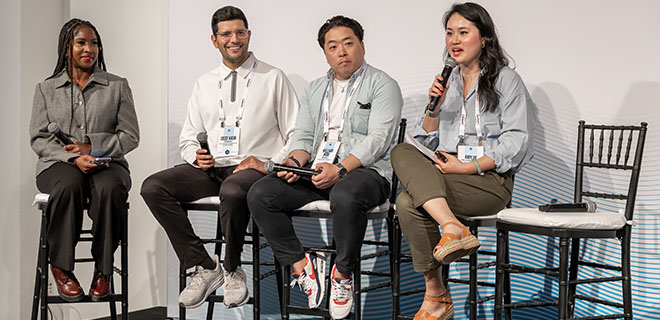
With workplaces now comprising employees from four distinct generations and each generation often critiquing the work ethic of the other generations, leaders are facing a dilemma in which bridging the gaps has become an intricate endeavor.
Since the pandemic, the nature of how we work has fundamentally changed and it is more evident than ever that work styles vary between generations. Understanding some of the reasons behind generational preferences and behaviors can go a long way toward making sure everyone in the office feels appreciated.
In a discussion at AdMonsters Ops in NYC titled, “Generational Diversity for the Win,” Amy He, Industry Analyst Lead at Morning Consult; Josef Najim, Global Programmatic and Partnerships Lead with Reuters; William Won, Senior Director, Sales Operations for Brainly; and AdMonsters’ own Content Manager Yakira Young broke down the generational differences and how to work with them rather than against them.
According to Morning Consult’s 2023 State of Workers Report, remote work is losing its shine at some companies as some employees prefer to work in person. They see it as a way to increase productivity and separate their work and home life.
Despite work location, successfully leading multigenerational teams can be tough but with the right approach and some best practices, it is attainable.
Embracing the Power of Multigenerational Perspectives
Preferences toward in-person work and the reasons why people want to go into the office cross generational lines, but there are differences in how each generation approaches work, especially Gen Z.
Gen Z is typically stereotyped as a generation that is less engaged with work, logs off early, and embellishes the amount of time it takes them to complete a task. However, sometimes the lack of their perspectives at the table can make the difference in increasing traffic, engagement, or revenue for your brand and/or company.
Those who have been working professionally for many years and are more established in their careers and have a working routine that Gen Z does not yet have. This makes flexibility in working hours a bigger consideration for older generations. Notes Najim, it is up to the older people who are more established to help shepherd their Gen Z coworkers through their early career journey and show them how to get the job done while still remaining flexible.
In Won’s office, work styles differ not just from generation to generation, but also from department to department. “It’s important to identify what the differences are between teams and the generational gap between roles and create an environment with dynamic accountability of who is responsible for what and how everyone contributes to the larger goal,” he says.
Communication Can Be A Challenge – Especially For Gen Z
Communication can be harder for Gen Z who may have entered the workplace during the pandemic. Amy He says, “If you have a policy that is more remote work forward with a younger workforce, that’s something to bake into your communication strategy and also as you think about transitioning back into the office or a hybrid model, that’s something really to take note of as well.”
Take office culture for instance, Gen Z may not have been able to complete internships in the way the older generations were able to and possibly were hired in a fully remote environment so they may be more hesitant to introduce themselves to their coworkers when entering the office. Najim says he strives to take the time when he is in the office with his team to help introduce his Gen Z coworkers to others in the organization.
Creating a more inclusive environment comes down to making sure everyone feels their voice is heard. For Gen Z coworkers, that can be as simple as letting them explain a TikTok trend you don’t understand. In a more remote-forward environment, making time for face-to-face touchpoints with Gen Z can also help them to feel more connected, particularly if those touchpoints can happen outside the office in a more relaxed environment, such as at an off-campus lunch.
For all generations, it’s important to understand that people have different communication styles – how they like to communicate and how they prefer to be communicated with. Acknowledging these differences can make every member of the team feel supported.
Offer Support Regardless of Generation
Younger generations can often be stuck with menial tasks rather than being asked to contribute to discussions in a meaningful way, and all speakers in this session agreed this is a mistake that managers from older generations make.
Gen Z has its finger on the pulse of current trends in a way that older generations may not, and their thoughts are a valuable addition to the discussion, especially if that discussion is about marketing.
Stereotyping any generation is doing a disservice to the individual perspective we all have to offer, whether it is assuming an older person is technologically challenged or that a younger person doesn’t want to work. To keep moving forward and growing, it is crucial to acknowledge areas where others bring strengths you may not possess and to let go of your generational blindspots. Only then can we truly bridge the generational divide.